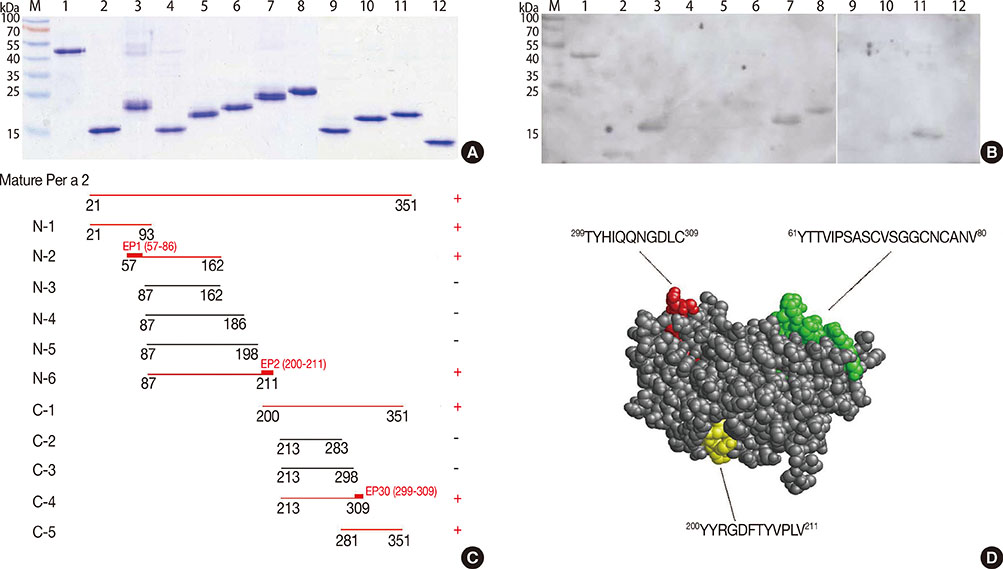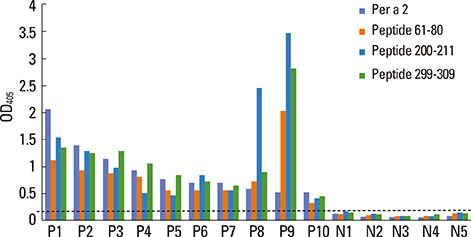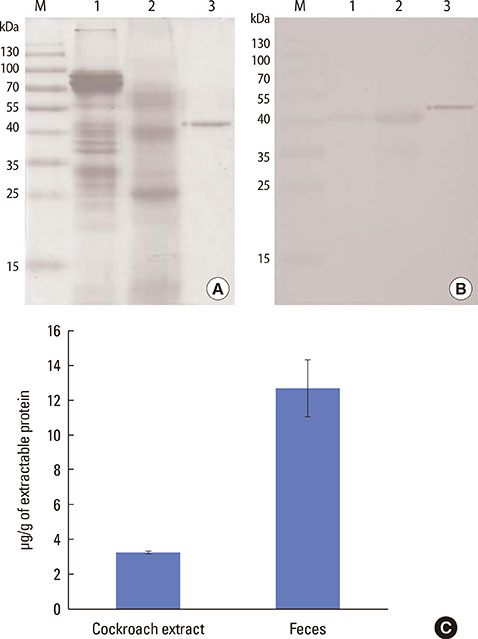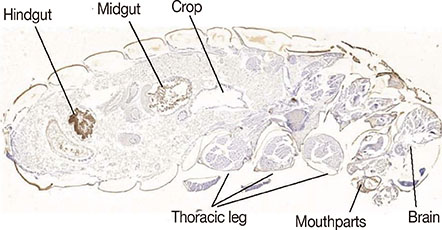Allergy Asthma Immunol Res.
2015 Jul;7(4):376-383. 10.4168/aair.2015.7.4.376.
IgE-Binding Epitope Mapping and Tissue Localization of the Major American Cockroach Allergen Per a 2
- Affiliations
-
- 1Department of Medical Research, Taichung Veterans General Hospital, Taichung, Taiwan.
- 2Division of Allergy, Immunology and Rheumatology, Taichung Veterans General Hospital, Taichung, Taiwan. ysanne@vghtc.gov.tw
- 3General Education Center, Tunghai University, Taichung, Taiwan.
- 4Department of Life Science, Tunghai University, Taichung, Taiwan.
- 5School of Medical Laboratory and Biotechnology, Chung Shan Medical University, Taichung, Taiwan.
- 6Faculty of Medicine, National Yang-Ming University, Taipei, Taiwan.
- KMID: 2166685
- DOI: http://doi.org/10.4168/aair.2015.7.4.376
Abstract
- PURPOSE
Cockroaches are the second leading allergen in Taiwan. Sensitization to Per a 2, the major American cockroach allergen, correlates with clinical severity among patients with airway allergy, but there is limited information on IgE epitopes and tissue localization of Per a 2. This study aimed to identify Per a 2 linear IgE-binding epitopes and its distribution in the body of a cockroach.
METHODS
The cDNA of Per a 2 was used as a template and combined with oligonucleotide primers specific to the target areas with appropriate restriction enzyme sites. Eleven overlapping fragments of Per a 2 covering the whole allergen molecule, except 20 residues of signal peptide, were generated by PCR. Mature Per a 2 and overlapping deletion mutants were affinity-purified and assayed for IgE reactivity by immunoblotting. Three synthetic peptides comprising the B cell epitopes were evaluated by direct binding ELISA. Rabbit anti-Per a 2 antibody was used for immunohistochemistry.
RESULTS
Human linear IgE-binding epitopes of Per a 2 were located at the amino acid sequences 57-86, 200-211, and 299-309. There was positive IgE binding to 10 tested Per a 2-allergic sera in 3 synthetic peptides, but none in the controls. Immunostaining revealed that Per a 2 was localized partly in the mouth and midgut of the cockroach, with the most intense staining observed in the hindgut, suggesting that the Per a 2 allergen might be excreted through the feces.
CONCLUSIONS
Information on the IgE-binding epitope of Per a 2 may be used for designing more specific diagnostic and therapeutic approaches to cockroach allergy.
MeSH Terms
-
Amino Acid Sequence
Cockroaches
DNA Primers
DNA, Complementary
Enzyme-Linked Immunosorbent Assay
Epitope Mapping*
Epitopes
Epitopes, B-Lymphocyte
Feces
Humans
Hypersensitivity
Immunoblotting
Immunoglobulin E
Immunohistochemistry
Mouth
Peptides
Periplaneta*
Polymerase Chain Reaction
Protein Sorting Signals
Taiwan
DNA Primers
DNA, Complementary
Epitopes
Epitopes, B-Lymphocyte
Immunoglobulin E
Peptides
Protein Sorting Signals
Figure
Reference
-
1. Holt PG, Thomas WR. Sensitization to airborne environmental allergens: unresolved issues. Nat Immunol. 2005; 6:957–960.2. Bernton HS, Brown H. Insect allergy--preliminary studies of the cockroach. J Allergy. 1964; 35:506–513.3. Lan JL, Lee DT, Wu CH, Chang CP, Yeh CL. Cockroach hypersensitivity: preliminary study of allergic cockroach asthma in Taiwan. J Allergy Clin Immunol. 1988; 82:736–740.4. Kang BC. Cockroach allergy. Clin Rev Allergy. 1990; 8:87–98.5. Rosenstreich DL, Eggleston P, Kattan M, Baker D, Slavin RG, Gergen P, et al. The role of cockroach allergy and exposure to cockroach allergen in causing morbidity among inner-city children with asthma. N Engl J Med. 1997; 336:1356–1363.6. Dubus JC, Guerra MT, Bodiou AC. Cockroach allergy and asthma. Allergy. 2001; 56:351–352.7. Katial RK. Cockroach allergy. Immunol Allergy Clin North Am. 2003; 23:483–499.8. Wilson NW, Robinson NP, Hogan MB. Cockroach and other inhalant allergies in infantile asthma. Ann Allergy Asthma Immunol. 1999; 83:27–30.9. Sookrung N, Chaicumpa W. A revisit to cockroach allergens. Asian Pac J Allergy Immunol. 2010; 28:95–106.10. Arruda LK, Vailes LD, Mann BJ, Shannon J, Fox JW, Vedvick TS, et al. Molecular cloning of a major cockroach (Blattella germanica) allergen, Bla g 2. Sequence homology to the aspartic proteases. J Biol Chem. 1995; 270:19563–19568.11. Chapman MD, Pomés A. Cockroach allergens, environmental exposure, and asthma. In : Kay AB, Kaplan AP, Bousquet J, Holt PG, editors. Allergy and allergic diseases. 2nd ed. Hoboken (NJ): Wiley-Blackwell;2008. p. 1131–1145.12. Jeong KY, Kim CR, Park J, Han IS, Park JW, Yong TS. Identification of novel allergenic components from German cockroach fecal extract by a proteomic approach. Int Arch Allergy Immunol. 2013; 161:315–324.13. Lee MF, Song PP, Hwang GY, Lin SJ, Chen YH. Sensitization to Per a 2 of the American cockroach correlates with more clinical severity among airway allergic patients in Tai wan. Ann Allergy Asthma Immunol. 2012; 108:243–248.14. Pomés A, Chapman MD. Can knowledge of the molecular structure of allergens improve immunotherapy? Curr Opin Allergy Clin Immunol. 2001; 1:549–554.15. Mackenzie KJ, Fitch PM, Leech MD, Ilchmann A, Wilson C, McFarlane AJ, et al. Combination peptide immunotherapy based on T-cell epitope mapping reduces allergen-specific IgE and eosinophilia in allergic airway inflammation. Immunology. 2013; 138:258–268.16. Worm M, Lee HH, Kleine-Tebbe J, Hafner RP, Laidler P, Healey D, et al. Development and preliminary clinical evaluation of a peptide immunotherapy vaccine for cat allergy. J Allergy Clin Immunol. 2011; 127:89–97. 97.e1–97.e14.17. Mackenzie KJ, Anderton SM, Schwarze J. Peptide immunotherapy for childhood allergy - addressing translational challenges. Clin Transl Allergy. 2011; 1:13.18. Matsumoto N, Okochi M, Matsushima M, Kato R, Takase T, Yoshida Y, et al. Peptide array-based analysis of the specific IgE and IgG4 in cow's milk allergens and its use in allergy evaluation. Peptides. 2009; 30:1840–1847.19. Wu CH, Lee MF, Tseng CY. IgE-binding epitopes of the American cockroach Per a 3 allergen. Allergy. 2003; 58:986–992.20. Wu CH, Lee MF, Yang JS, Tseng CY. IgE-binding epitopes of the American cockroach Per a 1 allergen. Mol Immunol. 2002; 39:459–464.21. Un S, Jeong KY, Yi MH, Kim CR, Yong TS. IgE binding epitopes of Bla g 6 from German cockroach. Protein Pept Lett. 2010; 17:1170–1176.22. Jeong KJ, Jeong KY, Kim CR, Yong TS. IgE-binding epitope analysis of Bla g 5, the German cockroach allergen. Protein Pept Lett. 2010; 17:573–577.23. Yi MH, Jeong KY, Kim CR, Yong TS. IgE-binding reactivity of peptide fragments of Bla g 1.02, a major German cockroach allergen. Asian Pac J Allergy Immunol. 2009; 27:121–129.24. Shin KH, Jeong KY, Hong CS, Yong TS. IgE binding reactivity of peptide fragments of Bla g 4, a major German cockroach allergen. Korean J Parasitol. 2009; 47:31–36.25. Lee H, Jeong KY, Shin KH, Yi MH, Gantulaga D, Hong CS, et al. Reactivity of German cockroach allergen, Bla g 2, peptide fragments to IgE antibodies in patients' sera. Korean J Parasitol. 2008; 46:243–246.26. Pan QR, Wang SM, Shang HS, Chew FT. Identification and characterization of Per a 2, the Bla g 2 allergen homologue from American cockroach (Periplaneta americana). J Allergy Clin Immunol. 2006; 117:S115.27. Gustchina A, Li M, Wünschmann S, Chapman MD, Pomés A, Wlodawer A. Crystal structure of cockroach allergen Bla g 2, an unusual zinc binding aspartic protease with a novel mode of self-inhibition. J Mol Biol. 2005; 348:433–444.28. Glesner J, Wünschmann S, Li M, Gustchina A, Wlodawer A, Himly M, et al. Mechanisms of allergen-antibody interaction of cockroach allergen Bla g 2 with monoclonal antibodies that inhibit IgE antibody binding. PLoS One. 2011; 6:e22223.29. Li M, Gustchina A, Glesner J, Wünschmann S, Vailes LD, Chapman MD, et al. Carbohydrates contribute to the interactions between cockroach allergen Bla g 2 and a monoclonal antibody. J Immunol. 2011; 186:333–340.30. Li M, Gustchina A, Alexandratos J, Wlodawer A, Wünschmann S, Kepley CL, et al. Crystal structure of a dimerized cockroach allergen Bla g 2 complexed with a monoclonal antibody. J Biol Chem. 2008; 283:22806–22814.31. Lee MF, Wang NM, Han JL, Lin SJ, Tsai JJ, Chen YH. Estimating allergenicity of latex gloves using Hev b 1 and hevamine. J Investig Allergol Clin Immunol. 2010; 20:499–505.32. Lin J, Bruni FM, Fu Z, Maloney J, Bardina L, Boner AL, et al. A bioinformatics approach to identify patients with symptomatic peanut allergy using peptide microarray immunoassay. J Allergy Clin Immunol. 2012; 129:1321–1328.e5.33. Sookrung N, Khetsuphan T, Chaisri U, Indrawattana N, Reamtong O, Chaicumpa W, et al. Specific B-cell epitope of per a 1: a major allergen of American cockroach (Periplaneta americana) and anatomical localization. Allergy Asthma Immunol Res. 2014; 6:325–332.34. Wu HQ, Liu ZG, Gao B, Li M, Ran PX, Xing M. Localization of Per a 3 allergen in the gut and faecal pellets of the American cockroach (Periplaneta americana). Int J Immunogenet. 2007; 34:347–351.35. Yun YY, Ko SH, Park JW, Lee IY, Ree HI, Hong CS. Comparison of allergenic components between German cockroach whole body and fecal extracts. Ann Allergy Asthma Immunol. 2001; 86:551–556.36. Tungtrongchitr A, Sookrung N, Indrawattana N, Sae-Lim J, Puduang S, Phonrat B, et al. Seasonal levels of the major American cockroach allergen per a 9 (arginine kinase) in Bangkok and their relevance for disease severity. Asian Pac J Allergy Immunol. 2009; 27:1–7.37. Pomés A, Chapman MD, Vailes LD, Blundell TL, Dhanaraj V. Cockroach allergen Bla g 2: structure, function, and implications for allergic sensitization. Am J Respir Crit Care Med. 2002; 165:391–397.38. Erban T, Stejskal V, Aulicky R, Krizkova-Kudlikova I, Nesvorna M, Hubert J. The influence of environmental temperature and humidity on temporal decomposition of cockroach allergens Bla g 1 and Bla g 2 in feces. J Med Entomol. 2010; 47:1062–1070.39. Zhou B, Yuan J, Zhou Y, Yang J, James AW, Nair U, et al. The attenuation of cockroach allergy by DNA vaccine encoding cockroach allergen Bla g 2. Cell Immunol. 2012; 278:120–124.
- Full Text Links
- Actions
-
Cited
- CITED
-
- Close
- Share
- Similar articles
-
- IgE Binding Reactivity of Peptide Fragments of Bla g 4, a Major German Cockroach Allergen
- Reactivity of German Cockroach Allergen, Bla g 2, Peptide Fragments to IgE Antibodies in Patients' Sera
- Specific B-cell Epitope of Per a 1: A Major Allergen of American Cockroach (Periplaneta americana) and Anatomical Localization
- IgE binding patterns to German cockroach whole body extract in Korean atopic asthmatic children
- Allergenic Characterization of a Novel Allergen, Homologous to Chymotrypsin, from German Cockroach





